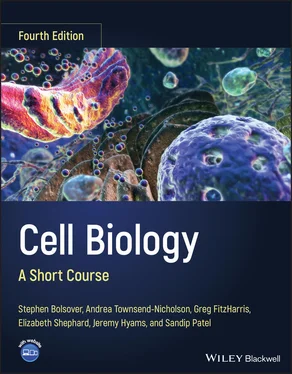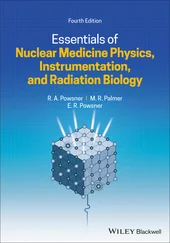Stephen R. Bolsover - Cell Biology
Здесь есть возможность читать онлайн «Stephen R. Bolsover - Cell Biology» — ознакомительный отрывок электронной книги совершенно бесплатно, а после прочтения отрывка купить полную версию. В некоторых случаях можно слушать аудио, скачать через торрент в формате fb2 и присутствует краткое содержание. Жанр: unrecognised, на английском языке. Описание произведения, (предисловие) а так же отзывы посетителей доступны на портале библиотеки ЛибКат.
- Название:Cell Biology
- Автор:
- Жанр:
- Год:неизвестен
- ISBN:нет данных
- Рейтинг книги:3 / 5. Голосов: 1
-
Избранное:Добавить в избранное
- Отзывы:
-
Ваша оценка:
- 60
- 1
- 2
- 3
- 4
- 5
Cell Biology: краткое содержание, описание и аннотация
Предлагаем к чтению аннотацию, описание, краткое содержание или предисловие (зависит от того, что написал сам автор книги «Cell Biology»). Если вы не нашли необходимую информацию о книге — напишите в комментариях, мы постараемся отыскать её.
Cell Biology: A Short Course
Cell Biology: A Short Course
Cell Biology: A Short Course
Cell Biology — читать онлайн ознакомительный отрывок
Ниже представлен текст книги, разбитый по страницам. Система сохранения места последней прочитанной страницы, позволяет с удобством читать онлайн бесплатно книгу «Cell Biology», без необходимости каждый раз заново искать на чём Вы остановились. Поставьте закладку, и сможете в любой момент перейти на страницу, на которой закончили чтение.
Интервал:
Закладка:
5 Mitochondria produce the energy currency ATP.
6 Peroxisomes carry out a number of reactions, including the destruction of hydrogen peroxide.
7 The ER is a major site of protein synthesis. Cell stimulation can often cause calcium ions stored in the ER to be released into the cytosol.
8 The Golgi apparatus is concerned with the modification of proteins after they have been synthesized.
9 Lysosomes contain powerful degradative enzymes that degrade material.
10 Organelles form membrane contact sites with other organelles and the plasma membrane to allow information flow.
11 Tight junctions prevent the passage of extracellular water or solute between the cells of an epithelium.
12 Gap junctions allow solute and electrical current to pass from the cytosol of one cell to the cytosol of its neighbor.
13 Anchoring junctions form a strong physical link between cells.
FURTHER READING
1 Balda, M. S. & Matter, K. (2008). Tight junctions at a glance. Journal of Cell Science 121: 3677–3682.
2 Duchen, M. R. (2004). Mitochondria in health and disease: perspectives on a new mitochondrial biology. Molecular Aspects of Medicine 25: 365–451.
3 Dundr, M. & Misteli, T. (2001). Functional architecture in the cell nucleus. Biochemical Journal 356: 297–310.
4 Gall, J. G. & McIntosh, J. R. (2001). Landmark Papers in Cell Biology. New York: Cold Spring Harbor Laboratory Press. 544 pp.
5 Lamond, A. I. & Earnshaw, W. C. (1998). Structure and function in the nucleus. Science 280: 547–553.
6 Platt, F. M. et al. (2018). Lysosomal storage diseases. Nature Reviews Disease Primers 4 (27).
7 Short, B. & Barr, F. A. (2000). The Golgi apparatus. Current Biology 10: R583–585.
8 van der Klei, I. & Veenhuis, M. (2002). Peroxisomes: flexible and dynamic organelles. Current Opinion in Cell Biology 14: 500–505.
9 Wu, H, Carvalho, P, & Voeltz, G. K. 2018). Here, there, and everywhere: the importance of ER membrane contact sites. Science 361 (6401): eaan5835.
 REVIEW QUESTIONS
REVIEW QUESTIONS
1 2.1 Theme: Membranesthe membrane or set of membranes surrounding the ERthe membrane or set of membranes surrounding the Golgi apparatusthe membrane or set of membranes surrounding the lysosomethe membrane or set of membranes surrounding the mitochondrionthe membrane or set of membranes surrounding the peroxisomethe plasma membraneFrom the above list, select the membrane that best fits the descriptions below.a double layer comprising an inner and an outer membraneis continuous with a membrane surrounding the nucleusforms a set of flattened sacks called cisternaeoften contains connexons as integral membrane proteinssurrounds a space containing calcium ions at a much higher concentration than in the cytosol. This store of calcium ions can be released into the cytosol upon cell stimulation. (Other such releasable calcium stores may exist in cells, but this is the largest.)
2 2.2 Theme: Organelles in eukaryotic cells endoplasmic reticulumGolgi apparatuslysosomemitochondrionnucleusperoxisomeFrom the above list of organelles, select the organelle described by each of the descriptions below.a major site of protein synthesiscontains many powerful digestive enzymescontains small circular chromosomescontains the enzyme catalasefilled with chromatinmade up of flattened sacks called cisternaemost of the cell's ATP is made hereusually found at the cell center
3 2.3 Theme: Transport across membranescan move from the cytosol of one cell to the cytosol of a neighboring cell, crossing the lipid bilayer component of each cell's plasma membrane as it does socannot cross lipid bilayers, but can move from the cytosol of one cell to the cytosol of a neighboring cell via gap junctionscannot move to a neighboring cell either by crossing the lipid bilayer component of the plasma membrane or via gap junctionsAbove we list three different possible constraints on the movement of a cytosolic solute. For each of the molecules below, state which of the three conditions apply.an RNA molecule of Mr = 10 000. As we will describe later, in Chapter 5, RNA molecules bear many negative chargesinositol trisphosphate, a small charged molecule of Mr = 649K+ (atomic weight = 39)nitric oxide (NO) (Mr = 30)
Review question covering chapters 1 and 2: Some basic components of the eukaryotic cell

Identify each of the cellular components below from the figure above.
1 cytosol
2 internal membranes
3 mitochondrion
4 nucleus
5 plasma membrane
 THOUGHT QUESTION
THOUGHT QUESTION
Why might it be useful for the genome to code for many connexin isoforms, some of which are incompatible with each other?
SECTION 2
THE MOLECULAR BIOLOGY OF THE CELL
The central dogma of molecular biology is “DNA makes RNA makes protein.” That central concept defines the structure of this section of the book, which moves from DNA through RNA to the synthesis of proteins. Single‐celled organisms change their behavior by altering the spectrum of RNAs and proteins that they make, while the cells of an animal or plant differentiate into different cell types by selecting different RNAs and proteins to synthesize. We will therefore describe the control mechanisms that operate to allow selective synthesis and readout of RNA. We will describe the ribosome, the machine for making protein using the instructions on DNA, and then describe the many and varied structures and behaviors of proteins. Lastly, in Chapter 8, we will describe some of the techniques that have made molecular biology such a powerful technology for both manipulating and investigating cells and organisms.
Chapter 3: DNA Structure and the Genetic Code
Chapter 4: DNA as a Data Storage Medium
Chapter 5: Transcription and the Control of Gene Expression
Chapter 6: Manufacturing Protein
Chapter 7: Protein Structure
Chapter 8: Recombinant DNA Technology and Genetic Engineering
3 DNA STRUCTURE AND THE GENETIC CODE
Our genes are made of deoxyribonucleic acid ( DNA). This remarkable molecule contains all of the information needed to make a cell and to pass on this information when a cell divides. This chapter describes the structure and properties of DNA molecules, the way in which our DNA is packaged into chromosomes, and how the information stored within DNA is retrieved via the genetic code.
 THE STRUCTURE OF DNA
THE STRUCTURE OF DNA
Deoxyribonucleic acid is an extremely long polymer made from monomeric units called deoxyribonucleotides (dNTPs),which are often simply called nucleotides.Nucleotides are made up of three components: a base, a sugar, and a phosphate group. Figure 3.1shows a deoxyribonucleotide, deoxyadenosine triphosphate, on the left. On the right is the corresponding ribonucleotide, adenosine triphosphate or ATP. As mentioned in Chapter 2, ATP is the cell's primary energy currency. As we will see in Chapter 5, ATP also plays a critical role as one of the four nucleotides in RNA, taking the place of the deoxyadenosine triphosphate in DNA. Note that deoxyribose, unlike ribose, has no hydroxyl(OH) group on its 2′ carbon.
Читать дальшеИнтервал:
Закладка:
Похожие книги на «Cell Biology»
Представляем Вашему вниманию похожие книги на «Cell Biology» списком для выбора. Мы отобрали схожую по названию и смыслу литературу в надежде предоставить читателям больше вариантов отыскать новые, интересные, ещё непрочитанные произведения.
Обсуждение, отзывы о книге «Cell Biology» и просто собственные мнения читателей. Оставьте ваши комментарии, напишите, что Вы думаете о произведении, его смысле или главных героях. Укажите что конкретно понравилось, а что нет, и почему Вы так считаете.












